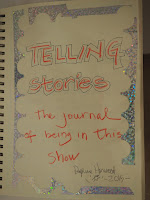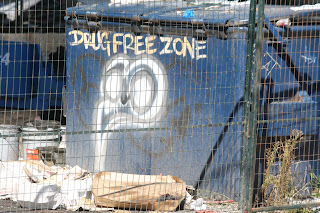Phyllis Schwartz was a friend going back to 1972 when I first met her. I was pregnant, unknowingly, with Erica & Lesley at the time.
She was the one who invited me to be in the show.
Phyllis knew that I was sitting on the edge of a neighborhood that was under enormous change & was documenting it. So on the basis of being already engaged with this story, I was invited into this show with 8 other artists.
Under ordinary circumstances I wouldn't have gone back to revisit the years that I was engaged with the project I co-started in 1981, The Imagination Market. It was done, past, & my life had moved on. But I moved into the neighborhood where this project had its first home & so I started, in some ways, haunting those streets, seeing what was going on there. There was a lot happening!
In 1989 Imagination Market moved to Powell Street & folded in there 1992. But a couple of years later three women who had worked with Imagination Market decided to start a new project. They called it Urban Source. The name fit, because this is a singularly urban project.
And for me, back in 1981 when I began this work, I realized that Vancouver was a singularly safe city of a woman to look for fascinating waste materials in alleys & factories & dumpsters!!
My first thought was to construct a map on cloth. A map was good because that project was an amazing way that I got to know Vancouver. I had arrived here in December of 1967. I had become a landed immigrant in February of 1968. So in 1981 when I gathered my thoughts & purpose to start this project I had been here only13 years.
So below was the very beginning of my map of where the Imagination Market took me. The yellow was where I was collecting from business in the early days. I dotted all the original members of the Board of our Association, the places where I and those board members lived, the organizations that helped us, & finally the places where the Imagination Market had a presence. I had to research where all the various dots went.
My next endeavor was to look at the materials available to me. Waste materials from Urban Source & my own scrap materials were my sources.
This was my very beginning start inside the green rectangle.
It quickly became obvious that I was going to make a very traditional 'quilt' from paper/plastic materials. So I came to call it a non/traditional quilt. The look of it is very old fashioned. The papers in the quilt were scraps from an old projects & stuff from Urban Source. The glitz in the middle is transfer foil from the printing industry.
A detail showing the different papers I used, including Braille paper.
My idea was to mount the best photos onto transparent cloth. The photos would be like the windows of a building. Transparent cloth would carry the meaning of impermanence. I had a dream about a newly made building loosing large chunks out of it, just like the chunks of concrete I had noticed missing from the Bridge.
I struggled quite a bit with how I was going to suspend the photo panels. Many thinkings & virtual testings of possibilities during the night, even.
Anyway 5 panels eventually emerged. The first was about the 1435 Granville Street building and the very early days of the Imagination Market Project. Four details.
The 3rd panel was about demolition of all the buildings & the beginning of the excavation of the site. The largest building to come down was the Mini Storage Building that was used by Westbank Developers to present the Vancouver House project to the city & potential buyers. The building as renamed Gesampt Kunst Werk.
I was curious about the history of the block, when 1435 was built & who occupied it. This was to be my final piece for the show. And another map-approach was in the offing.
I made a journal of the making of the work. That book is on the plinth at the left. And the model 1435 Granville Street Building is on the right. By a curious chain of events Regis Painchaud had this ceramic slab-constructed model. He loaned it to me for the show. And Philip Lander, who had run Imagination Market with Roberta Meillieur, gave me a jacket from the day.
















































































